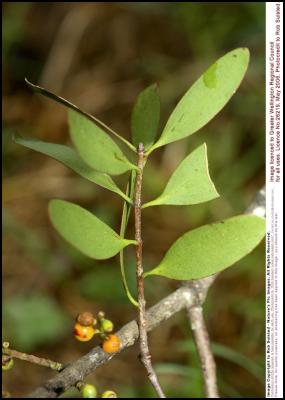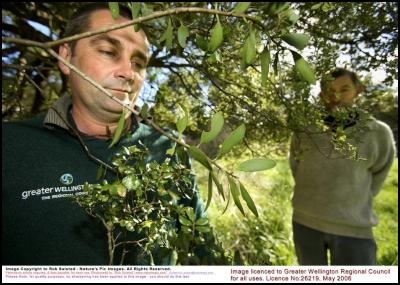Historic rediscovery of 'extinct' mistletoe
Historic rediscovery of mistletoe thought to be extinct

Click to enlarge

Click to enlarge
News release
13 June
2006
Historic rediscovery of mistletoe thought to be extinct
Ecologists and conservationists are amongst those brimming with excitement following an historic rediscovery of a native mistletoe thought to be extinct in the Wellington region.
The yellow mistletoe, Alepis flavida was recently found on the banks of the Kaiwhata River in Eastern Wairarapa, the same area where it was last seen in1947.
The discovery was made by Greater Wellington biosecurity officer Harvey Phillips during a routine pest plant inspection on a 16 hectare property in the isolated Ngahape Valley.
Over the years Harvey has found hundreds of mistletoe throughout the region, but none are as important as this.
“Yellow mistletoe, rare in the North Island, and up until now believed to be extinct in the Wellington region, is still quite common in areas of the South Island,” says Harvey. “It uses host trees for support, nutrients and water and can grow up to two metres across, mostly on mountain or black beech trees, and is dispersed by the bellbird.”
“The mistletoes provide native birds with much needed nectar and food that is often scarce in forests.”
“It is thought that constant browsing from possums has seen the plant go from being relatively common to almost extinct. This discovery just goes to show what can be achieved by intensive possum control. I very much hope that we find more of these plants in the future.”
Property owners, Emily Friedlander and Bernard West, are equally excited about the find. “We’re privileged to be guardians of such a rare plant,” says Emily. “We’re passionate about our environment, having farmed organically here for over ten years. This is our nature reserve where we run an English Language homestay and a private walk. We grow natives, fruit, trees, firewood trees, nuts and now yellow mistletoe! We’re delighted.”
Department of Conservation botanist John
Sawyer, who confirmed the discovery, says, “This is
significant. Harvey’s name will go down in history for this.
It’s almost sixty years since Alepis flavida was found in
the region and our goal now is to ensure that it continues
to survive and become self-sustaining.”
“It’s great to be
able to say once again that we have eight indigenous species
of mistletoe in the region, seven of which are endemic to
New Zealand, meaning that they are found nowhere else in the
world.”
A specimen of the yellow mistletoe will soon be stored at the Te Papa herbarium in Wellington so interested people will be able to see it for themselves.
ENDS
For information on Kaiwhata Walk visit www.kaiwhatawalk.co.nz


 Imported Motor Vehicle Industry Association: EV Battery Fires Expose New Zealand Regulatory Gap
Imported Motor Vehicle Industry Association: EV Battery Fires Expose New Zealand Regulatory Gap  Electricity Authority: Electricity Authority Welcomes Plan To Empower Consumers And ‘Make NZ More Electric’
Electricity Authority: Electricity Authority Welcomes Plan To Empower Consumers And ‘Make NZ More Electric’ Pamu Farms: New Zealand Farm Dog Genetic Study Shows Top Five Health Risks
Pamu Farms: New Zealand Farm Dog Genetic Study Shows Top Five Health Risks EDANZ: Payments NZ Forcing The World’s Most Aggressive Removal Of EFTPOS Terminals
EDANZ: Payments NZ Forcing The World’s Most Aggressive Removal Of EFTPOS Terminals Great Journeys New Zealand: Back By Popular Demand, The Southerner Returns
Great Journeys New Zealand: Back By Popular Demand, The Southerner Returns New Zealand Association of Scientists: Budget 2025 Robs Researchers To Pay For Regulation
New Zealand Association of Scientists: Budget 2025 Robs Researchers To Pay For Regulation


